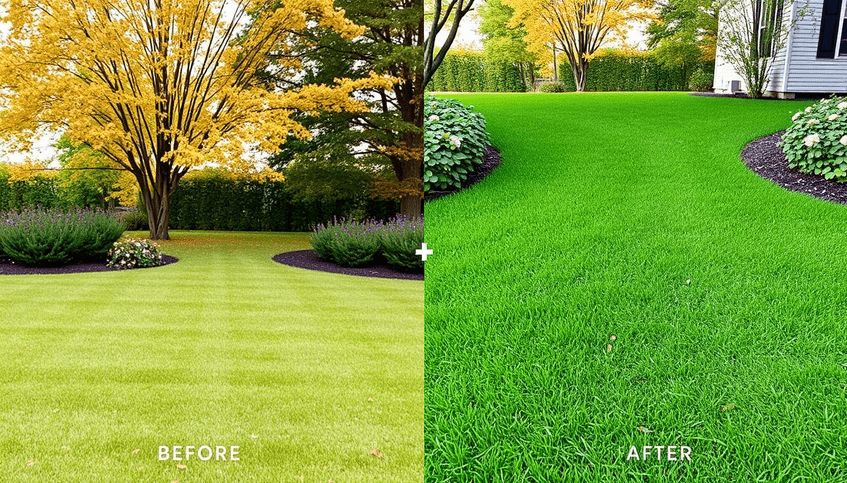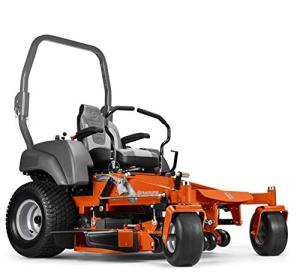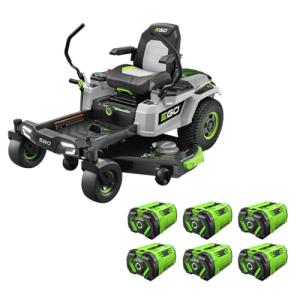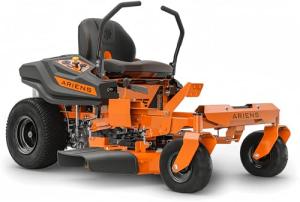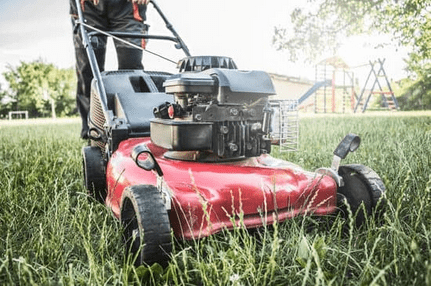Why Fall Fertilization Is Critical for Lawn Health:
As summer fades and temperatures drop, your lawn is preparing for winter dormancy. What many homeowners don't realize is that fall might be the most crucial season for lawn fertilization. The right nutrients applied during autumn strengthen root systems, store energy reserves, and set the stage for a lush, green lawn when spring arrives. This comprehensive fall fertilizer guide will walk you through everything you need to know about feeding your lawn before winter—from timing and product selection to application methods and common mistakes to avoid.

Fall fertilization strengthens roots and prepares your lawn for winter dormancy
While spring might seem like the obvious time to focus on lawn care, fall fertilization offers unique benefits that can't be achieved during other seasons. As temperatures cool, grass shifts its growth energy from leaf development to root strengthening and nutrient storage. This makes autumn the perfect time to provide your lawn with the resources it needs to survive winter and thrive next spring.
Key Benefits of Fall Fertilization:
- Strengthens root systems before winter dormancy
- Improves resistance to disease, drought, and cold stress
- Stores essential nutrients for early spring green-up
- Reduces weed competition the following season
- Enhances lawn density and color before and after winter
Unlike spring fertilization, which primarily stimulates leaf growth, fall applications focus on building stronger foundations. The nutrients absorbed during autumn remain available in the soil and root system, ready to fuel rapid recovery when temperatures warm again. This timing advantage makes fall fertilizer applications among the most efficient and effective in your annual lawn care routine.
Types of Fall Fertilizers: Choosing the Right Formula
Not all fertilizers are created equal, especially when it comes to fall applications. The ideal autumn fertilizer differs significantly from what you might use in spring or summer. Understanding these differences helps you select products that provide the right balance of nutrients for your lawn's seasonal needs.
Understanding NPK Ratios for FallFertilizers are labeled with three numbers representing the NPK ratio—nitrogen (N), phosphorus (P), and potassium (K). For fall applications, you'll want to adjust this ratio compared to other seasons:
| Nutrient | Spring Role | Fall Role | Ideal Fall Levels |
| Nitrogen (N) | High (promotes leaf growth) | Moderate to low (prevents tender growth) | Lower than spring (8-10% for late fall) |
| Phosphorus (P) | Moderate | Higher (promotes root development) | 10-12% for most lawns |
| Potassium (K) | Low to moderate | High (improves cold hardiness) | 14-20% for winter protection |
Slow-Release vs. Quick-Release Fertilizers
Slow-Release Benefits:
- Gradual nutrient delivery over 6-8 weeks
- Reduced risk of burning the lawn
- Fewer applications needed
- Less nutrient runoff and environmental impact
Quick-Release Considerations:
- Immediate nutrient availability
- Faster visible results
- Higher risk of lawn burn if overapplied
- Shorter effective period (3-4 weeks)
For fall applications, slow-release fertilizers generally provide better long-term benefits, allowing nutrients to remain available as the lawn prepares for and enters dormancy. However, a combination approach can be effective—using quick-release early in fall for recovery from summer stress, followed by slow-release formulations later in the season.
Organic vs. Synthetic Fall Fertilizers
Organic Fertilizers
- Improve soil structure and microbial activity
- Naturally slow-release for extended feeding
- Lower risk of burning the lawn
- Environmentally friendly option
Synthetic Fertilizers
- Precise nutrient ratios for specific needs
- More concentrated (less product needed)
- Often less expensive per square foot
- Faster initial results
Get Your Lawn Ready for Winter
Our Premium Fall Lawn Fertilizer provides the perfect balance of nutrients to strengthen roots and prepare your lawn for winter. Specially formulated with higher potassium for cold tolerance.
Shop Fall FertilizersOptimal Timing for Fall Fertilizer Application
Timing is perhaps the most critical factor in fall fertilization. Apply too early, and you might promote excessive top growth; too late, and the nutrients won't be properly absorbed before dormancy. The ideal window depends on your grass type and local climate conditions.
Cool-Season Grasses (Northern Regions)
Cool-season grasses like Kentucky bluegrass, fescue, and ryegrass experience their primary growth period during fall. This makes autumn fertilization especially important for these varieties.
Recommended Application Schedule:
- Early Fall (September): Apply a balanced fertilizer with moderate nitrogen to support recovery from summer stress and encourage root development.
- Late Fall (October-November): Apply a winterizer fertilizer with higher potassium and lower nitrogen approximately 2-3 weeks before the ground freezes.
Warm-Season Grasses (Southern Regions)
Warm-season grasses like Bermuda, zoysia, and St. Augustine have different fall fertilization needs as they prepare to enter dormancy during cooler months.
Important Timing Considerations:
- Early Fall (September): Last nitrogen application to help recover from summer stress.
- Mid-Fall: Switch to potassium-rich, low-nitrogen fertilizers.
- Late Fall: Avoid nitrogen completely to prevent delaying dormancy and increasing winter damage risk.
Regional Frost Date Considerations
Local frost dates should guide your fertilization schedule. As a general rule:
| Region | First Frost (Average) | Final Fertilizer Deadline |
| Northern States | Mid-October | Late September to early October |
| Mid-Atlantic | Late October | Early to mid-October |
| Southern States | November to December | Mid to late October |
| Transition Zone | Late October | Early October |
Know Your Soil Before Fertilizing
Get a professional soil test to determine exactly what your lawn needs this fall. Our comprehensive analysis identifies nutrient deficiencies and pH imbalances.
Order Soil Test KitFall Fertilizer Application Methods
Proper application technique ensures even distribution and maximum nutrient absorption. The two main methods—granular and liquid—each have advantages depending on your lawn size, equipment, and personal preference.
Granular Fertilizer Application

Step-by-Step Application Guide:
- Mow your lawn 2-3 days before application
- Choose a day with minimal wind and no rain in the forecast for 24 hours
- Fill the spreader on a hard surface to avoid spills on the lawn
- Set the spreader to the rate recommended on the fertilizer package
- Apply in a criss-cross pattern for even coverage (north-south, then east-west)
- Water lightly after application to activate the fertilizer
Spreader Types:
- Broadcast/Rotary: Covers large areas quickly with wide distribution pattern
- Drop Spreader: More precise application for smaller lawns or areas near gardens
- Hand-held: Best for very small lawns or spot treatments
Safety Tips:
- Wear gloves to prevent skin contact
- Keep children and pets off treated areas until watered in
- Clean spreader thoroughly after use
- Store unused fertilizer in a dry, cool place
Liquid Fertilizer Application
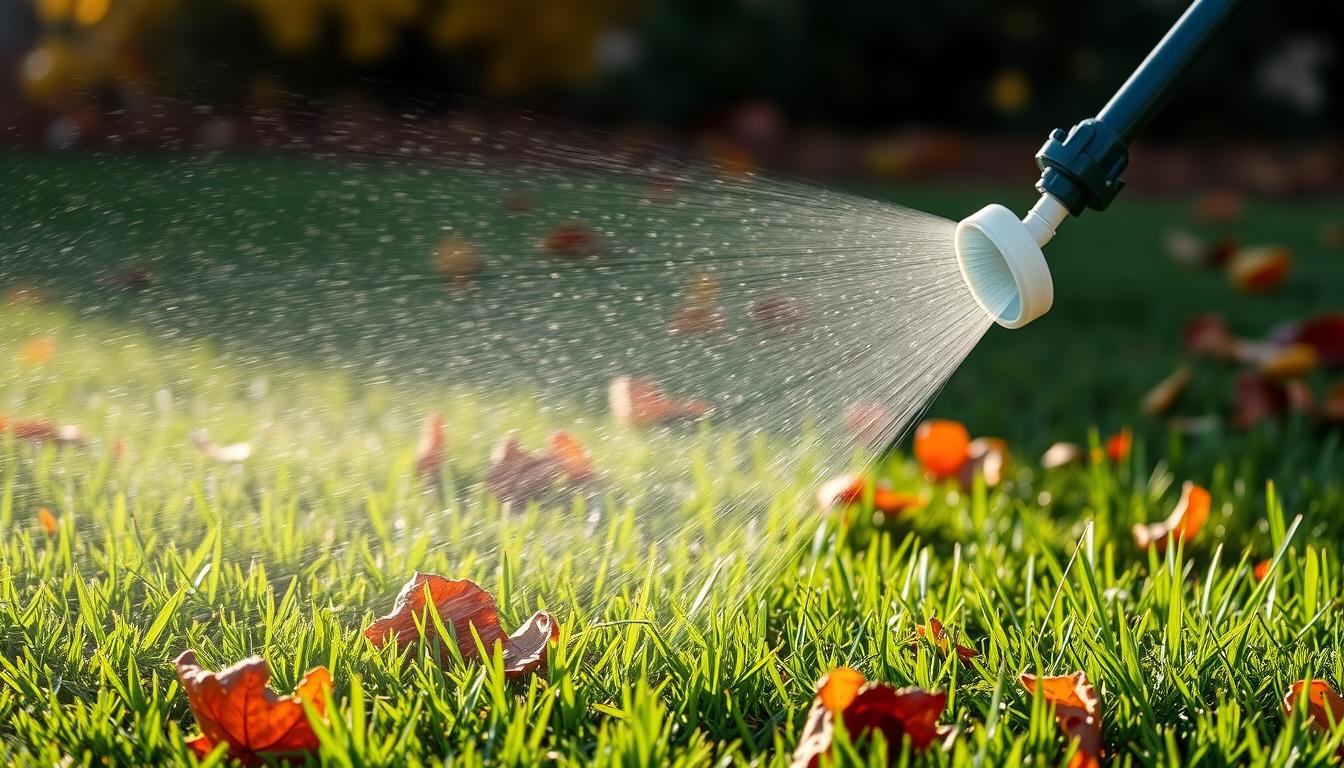
Application Process:
- Choose a calm day with no rain forecast for 24 hours
- Dilute concentrate according to package directions
- Fill sprayer with the prepared solution
- Apply evenly using a consistent walking pace
- Consider marking sections to ensure complete coverage
- No immediate watering needed (unless specified on product label)
"Liquid fertilizers provide faster initial nutrient availability, making them ideal for the early fall application when you want to help your lawn recover quickly from summer stress."
Post-Fertilization Care for Maximum Benefits
What you do after applying fall fertilizer significantly impacts its effectiveness. Proper post-application care ensures nutrients reach the root zone and aren't wasted through runoff or volatilization.
Watering Schedule After Fertilization

Watering Guidelines:
- Granular Fertilizers: Water lightly (about 1/4 inch) immediately after application to dissolve granules
- Liquid Fertilizers: Usually no immediate watering needed unless specified on the label
- Follow-up Watering: Maintain normal irrigation schedule (1-1.5 inches per week) unless rainfall is adequate
- Best Time: Water early morning to reduce evaporation and disease risk
Mowing Recommendations
Proper mowing height during fall helps maximize fertilizer benefits and prepares your lawn for winter:
| Grass Type | Early Fall Height | Late Fall Height | Mowing Frequency |
| Kentucky Bluegrass | 2.5-3 inches | 2-2.5 inches | Every 7-10 days |
| Tall Fescue | 3-3.5 inches | 2.5-3 inches | Every 10-14 days |
| Bermuda | 1.5-2 inches | 1-1.5 inches | As needed (growth slows) |
| Zoysia | 1.5-2.5 inches | 1.5-2 inches | As needed (growth slows) |
Signs of Over-Fertilization
Too much of a good thing can harm your lawn. Watch for these warning signs after fertilizing:
Over-Fertilization Symptoms:
- Leaf burn: Yellow or brown patches with crispy leaf tips
- Excessive growth: Unusually rapid, lush growth requiring frequent mowing
- Fertilizer crust: White or yellowish residue on soil surface
- Algae or moss: Increased growth, especially in shady areas
- Root damage: Shallow roots and reduced drought tolerance
If you notice these symptoms, water the lawn thoroughly to dilute the fertilizer and flush excess nutrients from the root zone. Avoid additional fertilization until the lawn recovers.
Common Fall Fertilization Mistakes to Avoid
Even experienced homeowners can make mistakes when fertilizing in fall. Avoiding these common errors will help you get maximum benefit from your fall fertilization program:
Using the Wrong Formula
Spring fertilizers are high in nitrogen to promote leaf growth—exactly what you don't want in late fall. Choose formulas specifically labeled for fall/winter with higher potassium content.
Skipping Soil Testing
Applying fertilizer without knowing your soil's needs wastes money and can harm your lawn. A simple soil test reveals exactly what nutrients your lawn requires.
Improper Timing
Fertilizing too late means nutrients won't be absorbed before dormancy. Aim to complete your final application at least 2-3 weeks before the ground freezes.
Inconsistent Application
Uneven spreading leads to patchy results with some areas over-fertilized and others undernourished. Use a quality spreader and maintain consistent walking speed.
Ignoring Weather Forecasts
Applying before heavy rain can cause runoff and waste fertilizer. Similarly, applying during drought conditions reduces effectiveness as nutrients need moisture to be absorbed.
One-Size-Fits-All Approach
Different grass types have different fall fertilization needs. What works for cool-season grasses can damage warm-season varieties if applied at the wrong time.
Not Sure Which Fertilizer Is Right for Your Lawn?
Our lawn care experts can help you select the perfect fall fertilizer based on your grass type, soil conditions, and local climate. Schedule a free consultation today!
Get Expert AdviceComplete Fall Lawn Winterization Checklist
Fall fertilization is just one component of a comprehensive winter preparation strategy. Combine these practices for the healthiest possible lawn come spring:

Early Fall Tasks (September)
- Test soil and address pH issues
- Apply first round of fall fertilizer
- Overseed thin or bare patches
- Control broadleaf weeds
- Continue regular mowing at summer height
Mid-Fall Tasks (October)
- Core aerate compacted soil
- Apply second round of fertilizer
- Gradually lower mowing height
- Remove leaves regularly
- Treat for grubs if necessary
Late Fall Tasks (November)
- Apply final winterizer fertilizer
- Complete final mowing at winter height
- Clean and store lawn equipment
- Winterize irrigation system
- Apply winter weed pre-emergent if needed
The Critical Role of Aeration
Fall aeration works synergistically with fertilization by:
- Breaking up compacted soil to improve nutrient penetration
- Enhancing root growth and development
- Improving water infiltration and reducing runoff
- Creating space for seed-to-soil contact during overseeding
For best results, aerate before applying your fall fertilizer to help nutrients reach the root zone more effectively.

Frequently Asked Questions About Fall Fertilizer
Can I fertilize my lawn after the first frost?
Light frost doesn't necessarily mean you should stop fertilizing. For cool-season grasses, you can still apply fertilizer after the first light frost as long as the ground isn't frozen and grass is still green. For warm-season grasses, it's best to complete all fertilization before the first frost to avoid delaying dormancy.
Is it better to fertilize before or after aerating in fall?
Ideally, aerate first, then fertilize. Aeration creates channels for fertilizer to reach deeper into the soil profile, maximizing nutrient availability to the roots. This sequence provides better fertilizer penetration and more efficient nutrient uptake.
How long should I wait to mow after applying fall fertilizer?
For granular fertilizers, wait until after you've watered the lawn and the grass blades are dry, typically 24-48 hours. For liquid fertilizers, follow product instructions, but generally waiting 24 hours is sufficient. Mowing too soon might disrupt the fertilizer distribution before it's properly absorbed.
What's the difference between "winterizer" and regular fall fertilizer?
Winterizer fertilizers typically contain higher levels of potassium (K) and lower nitrogen (N) compared to regular fertilizers. They're specifically formulated to enhance cold hardiness, disease resistance, and root strength during winter months. Regular fall fertilizers might have more balanced ratios suitable for early fall but less ideal for late-season application.
Should I fertilize newly sodded or seeded lawns in fall?
New lawns have different fertilization needs. For newly sodded lawns, wait 4-6 weeks after installation before applying fall fertilizer. For newly seeded areas, use a starter fertilizer at seeding time, then follow up with a regular fall application once the grass has been mowed 3-4 times. Always use a gentler application rate for new lawns.
Conclusion: Investing in Your Lawn's Future
Fall fertilization represents one of the best investments you can make in your lawn's long-term health. By providing the right nutrients at the right time, you're setting the stage for a stronger, more resilient lawn that will green up faster and resist stresses better in the coming year.
Remember that timing, product selection, and proper application techniques all play crucial roles in success. Take the time to understand your specific lawn's needs based on grass type, soil conditions, and local climate. When in doubt, soil testing provides the most accurate guidance for creating a customized fertilization plan.
Whether you choose to handle fall fertilization yourself or work with lawn care professionals, the effort you put in now will pay dividends when spring arrives. Your neighbors will wonder how your lawn looks so lush and green while theirs is still waking up from winter dormancy.
Share Your Fall Lawn Care Journey
What fall fertilization strategies have worked best for your lawn? Share your experiences, questions, and before/after photos in the comments below. Let's learn from each other and create the healthiest lawns possible!
Join the Conversation
DISCLAIMER
This document is provided for general information purposes only and should not be relied upon as providing legal advice, technical, or specific operational guidance to the reader, whether as to the practices described in the document or the applicable legal requirements and regulations. Lawnfly.com expressly disclaims any responsibility for liability arising from or related to the use or misuse of any information in this document.
